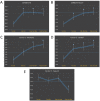Transcranial Pulse Stimulation with Ultrasound in Alzheimer's Disease-A New Navigated Focal Brain Therapy
- PMID: 32042569
- PMCID: PMC7001626
- DOI: 10.1002/advs.201902583
Transcranial Pulse Stimulation with Ultrasound in Alzheimer's Disease-A New Navigated Focal Brain Therapy
Abstract
Ultrasound-based brain stimulation techniques may become a powerful new technique to modulate the human brain in a focal and targeted manner. However, for clinical brain stimulation no certified systems exist and the current techniques have to be further developed. Here, a clinical sonication technique is introduced, based on single ultrashort ultrasound pulses (transcranial pulse stimulation, TPS) which markedly differs from existing focused ultrasound techniques. In addition, a first clinical study using ultrasound brain stimulation and first observations of long term effects are presented. Comprehensive feasibility, safety, and efficacy data are provided. They consist of simulation data, laboratory measurements with rat and human skulls and brains, in vivo modulations of somatosensory evoked potentials (SEP) in healthy subjects (sham controlled) and clinical pilot data in 35 patients with Alzheimer's disease acquired in a multicenter setting (including neuropsychological scores and functional magnetic resonance imaging (fMRI)). Preclinical results show large safety margins and dose dependent neuromodulation. Patient investigations reveal high treatment tolerability and no major side effects. Neuropsychological scores improve significantly after TPS treatment and improvement lasts up to three months and correlates with an upregulation of the memory network (fMRI data). The results encourage broad neuroscientific application and translation of the method to clinical therapy and randomized sham-controlled clinical studies.
Keywords: Alzheimer's disease; brain stimulation; ultrasound.
© 2019 The Authors. Published by WILEY‐VCH Verlag GmbH & Co. KGaA, Weinheim.
Conflict of interest statement
The authors declare no conflict of interest.
Figures



Similar articles
-
Functional Specificity of TPS Brain Stimulation Effects in Patients with Alzheimer's Disease: A Follow-up fMRI Analysis.Neurol Ther. 2022 Sep;11(3):1391-1398. doi: 10.1007/s40120-022-00362-8. Epub 2022 May 28. Neurol Ther. 2022. PMID: 35633496 Free PMC article.
-
Multimodal imaging of murine cerebrovascular dynamics induced by transcranial pulse stimulation.Alzheimers Dement. 2025 Feb;21(2):e14511. doi: 10.1002/alz.14511. Epub 2025 Jan 14. Alzheimers Dement. 2025. PMID: 39807706 Free PMC article.
-
First evidence of long-term effects of transcranial pulse stimulation (TPS) on the human brain.J Transl Med. 2022 Jan 15;20(1):26. doi: 10.1186/s12967-021-03222-5. J Transl Med. 2022. PMID: 35033118 Free PMC article.
-
Safety of Clinical Ultrasound Neuromodulation.Brain Sci. 2022 Sep 22;12(10):1277. doi: 10.3390/brainsci12101277. Brain Sci. 2022. PMID: 36291211 Free PMC article. Review.
-
Transcranial pulse stimulation in Alzheimer's disease.CNS Neurosci Ther. 2024 Feb;30(2):e14372. doi: 10.1111/cns.14372. Epub 2023 Jul 20. CNS Neurosci Ther. 2024. PMID: 37469252 Free PMC article.
Cited by
-
Image-Guided High-Intensity Focused Ultrasound, A Novel Application for Interventional Nuclear Medicine?J Nucl Med. 2021 Sep 1;62(9):1181-1188. doi: 10.2967/jnumed.120.256230. Epub 2021 Jun 4. J Nucl Med. 2021. PMID: 34088775 Free PMC article. Review.
-
Ultrasound Neuromodulation Reduces Demyelination in a Rat Model of Multiple Sclerosis.Int J Mol Sci. 2022 Sep 2;23(17):10034. doi: 10.3390/ijms231710034. Int J Mol Sci. 2022. PMID: 36077437 Free PMC article.
-
Effects of Transcranial Pulse Stimulation (TPS) on Adults with Symptoms of Depression-A Pilot Randomized Controlled Trial.Int J Environ Res Public Health. 2023 Jan 28;20(3):2333. doi: 10.3390/ijerph20032333. Int J Environ Res Public Health. 2023. PMID: 36767702 Free PMC article. Clinical Trial.
-
Focused ultrasound mitigates pathology and improves spatial memory in Alzheimer's mice and patients.Theranostics. 2023 Jul 14;13(12):4102-4120. doi: 10.7150/thno.79898. eCollection 2023. Theranostics. 2023. PMID: 37554284 Free PMC article.
-
General-Purpose Ultrasound Neuromodulation System for Chronic, Closed-Loop Preclinical Studies in Freely Behaving Rodents.Adv Sci (Weinh). 2022 Dec;9(34):e2202345. doi: 10.1002/advs.202202345. Epub 2022 Oct 19. Adv Sci (Weinh). 2022. PMID: 36259285 Free PMC article.
References
Grants and funding
LinkOut - more resources
Full Text Sources
Other Literature Sources
Medical
